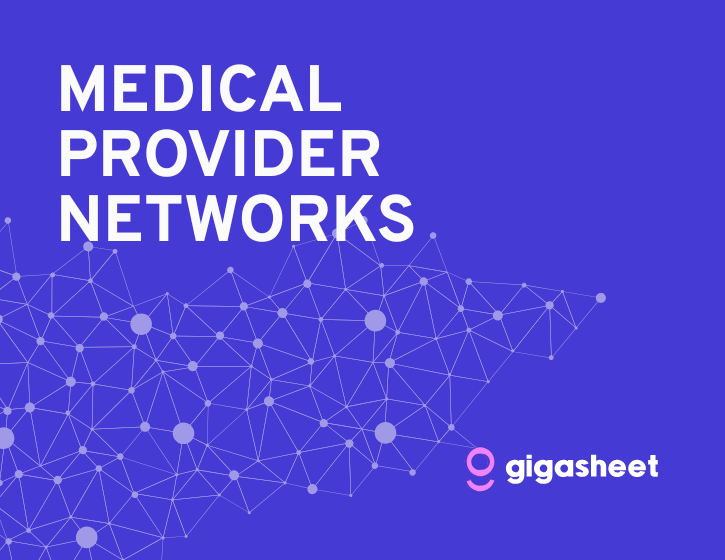Healthcare
Workers’ Comp Networks: Inside Gigasheet’s New California MPN Data

Medical Provider Networks (MPNs) sit at the heart of California’s workers’‑compensation system. Under state rules, an employer or workers’‑compensation carrier may establish a medical provider network. An MPN is a group of doctors and ancillary providers approved by the Division of Workers’ Compensation to treat employees injured on the job. Employers are not required to set up an MPN, but once an MPN is approved the injured employee generally must seek care from that network. Networks must contain licensed physicians, surgeons, psychologists, chiropractors and other ancillary providers, and the providers listed in the network must have contractual agreements to treat workers’‑compensation injuries in compliance with California law.
Traditionally these directories live in archaic formats. The Division of Workers’ Compensation still requires carriers to submit provider lists on compact discs (!) or flash drives as Excel spreadsheets. Many insurers post their MPN rosters as static PDF documents on third‑party portals, making them difficult to search or analyze at scale.The fragmentation of data across separate PDF rosters, static spreadsheets and network websites makes it hard for payers, providers and policymakers to understand how these networks are constructed.
Explore the California MPN Data
Why Gigasheet built a Workers’ Comp MPN dataset
At Gigasheet we're working to make healthcare market data, and intelligent insights more accessible. Our new California Workers’ Comp MPN datasets consolidate provider rosters from major insurers into a single, queryable sheet. Each record includes the provider’s name, specialty, practice address, and network affiliation. By aggregating these rosters, Gigasheet gives payers, provider groups and researchers a transparent view of who participates in each workers’‑compensation network.
The first extract covers nine of the largest workers’‑comp carriers operating in California. The Hartford network is by far the largest, with 64,965 physicians and specialists; Zurich’s network follows with 24,433 providers; and other carriers like Travelers, Zenith, CNA, AmTrust, the State Fund, Everest and Berkshire Hathaway maintain smaller networks. These counts align with the description on each Gigasheet sample page—for example, the Hartford dataset advertises 64,965 California physicians with 97 % specialty classifications, Zurich lists over 24,000 providers, CNA includes more than 7,500 providers and AmTrust counts 6,681 entries.
Note: Provider counts are based on our initial extract and may change as networks update their rosters.
Enriching MPN data
Bringing these rosters into Gigasheet is only the first step. We enrich the raw lists with additional healthcare and market‑intelligence data to make them more actionable:
- NPI registry enrichment – We cross‑reference each provider with the National Provider Identifier (NPI) database to add taxonomy codes, credential information, organization type and licensure status. NPI enrichment adds unique identifiers and improves data quality, enabling accurate matching with price transparency files and claims data.
- Geocoding and demographic context – We attach latitude/longitude and FIPS codes to each provider so users can analyze geographic distribution, identify underserved areas and evaluate network adequacy. Gigasheet’s public datasets like FIPS to city, state, county lookup and Zip Code to County are used to quickly map providers to counties and metropolitan areas.
- B2B sales intelligence – For sales and business development teams, we append company‑level information (e.g., practice ownership, provider group affiliation, decision‑maker contacts) from our B2B sales intelligence partners. This enrichment helps identify opportunities for vendor outreach and network contracting.
- Price transparency linkage – Because Gigasheet already processes billions of rows of machine‑readable price transparency data, we can link MPN providers to negotiated rates. This helps payers benchmark reimbursement against other networks and supports providers in contract negotiations.
Use cases for different stakeholders
Payers and network development teams. Insurance carriers and third‑party administrators can use the aggregated dataset to benchmark their provider networks against competitors. With over 64,000 providers in Hartford’s network and more than 24,000 in Zurich’s, the data reveals where networks are over‑ or under‑built and which specialties dominate each roster. Combining the dataset with geocoded information allows payers to test network adequacy standards—such as ensuring a minimum number of primary care physicians and specialists within specified travel distances and identify counties or specialties lacking sufficient coverage.
Provider groups and networks selling to insurers. Physician organizations can use the dataset to see where competitors are contracted and to identify gaps where insurers need additional providers. CNA’s network, for example, includes over 7,500 providers, while AmTrust lists 6,681 entries; understanding these rosters helps groups target insurers that lack certain specialties or geographic coverage. Enrichment with B2B intelligence also surfaces contact names and practice attributes, facilitating outreach for contracting discussions.
Researchers, consultants and policymakers. The aggregated dataset enables analysis of workers’‑comp healthcare access and market concentration. Researchers can compare network sizes. For example, Travelers’ nearly 16, 500 providers versus Berkshire Hathaway’s ≈2 500 providers to study how network breadth relates to claim outcomes or reimbursement. Policymakers can evaluate whether current MPN regulations are producing adequate geographic coverage and whether certain carriers rely heavily on a small number of providers.
Looking ahead
MPN data has long been hidden in static PDFs and outdated file formats. The California Division of Workers’ Compensation still instructs insurers to submit provider lists on physical media, and many networks host their rosters as unsearchable PDFs. Gigasheet’s new MPN datasets turn those documents into interactive data. By enriching them with NPI registry details, geocoding and B2B intelligence, we’re building a powerful tool for stakeholders across the workers’‑comp ecosystem. This launch marks the start of our expansion into workers’‑compensation market intelligence; future releases will bring in additional states, pricing data and claims metrics.
Ready to explore California’s workers’‑comp provider landscape? Contact our team for access to the full dataset across all networks and learn how Gigasheet’s no‑code big‑data platform can deliver actionable insights for your organization.
The ease of a spreadsheet. The power of price transparency.







.png)












